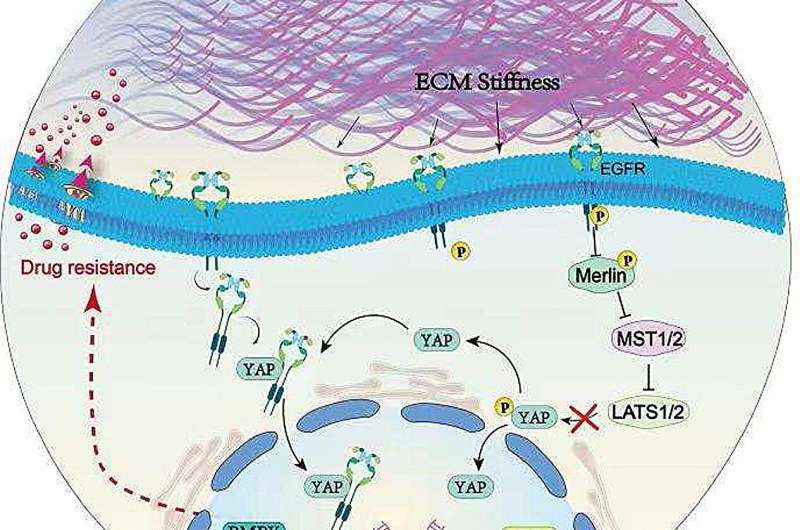This article has been reviewed according to Science X's editorial process and policies. Editors have highlighted the following attributes while ensuring the content's credibility:
fact-checked
proofread
Extracellular cell matrix stiffness may induce drug resistance of breast cancer cells

A new study, led by Prof. Liu from the department of pharmacy, University of Electronic Science and Technology of China, discovered that the extracellular cell matrix (ECM) could induce the drug resistance of breast cancer cells.
This study investigated the effect of ECM stiffness on breast cancer cells and revealed that the extracellular cell matrix stiffness mediated drug resistance of breast cancer cells via EGFR pathway. The findings are published in the journal Mechanobiology in Medicine.
One of the critical factors in cancer mortality is drug resistance during chemotherapy. Various factors contribute to drug resistance in cancer therapy, such as tumor burden and growth kinetics, tumor heterogeneity, physical obstacles, the immune system and the microenvironment, undruggable cancer drivers, and the numerous adverse effects of therapeutic pressures. Breast cancer is highly heterogeneous and aggressive. Extracellular cell matrix (ECM) plays a significant role in remodeling and stiffening during breast cancer progression.
The rigid ECM impedes chemotherapeutic agent penetration into tumor cells. The current reports show ECM stiffness plays a critical role in tumor cell behaviors, including proliferation, metastasis, abnormal angiogenesis, metabolic redox homeostasis, immune suppression, and genome instability.
These behaviors of tumors regulated by ECM stiffness also affect tumor cell response to therapeutic agents. The ECM of primary untreated TNBCs is rich in quantities of fibrillar-type collagens and was stiffer than that of the normal human breast.
Chemotherapy-resistant residual tumors inhabit a softer niche. Triple-negative breast cancer (TNBC) organoids cultured on soft ECM showed striking resistance to chemotherapy.
A previous study indicated that soft ECM promoted osteosarcoma cell drug resistance via the regulation of miR-29 downregulation. Although more and more attention has been paid to the effect of ECM stiffness on tumor resistance, the research presents conflicting findings.
The contradictory findings may be attributed to numerous factors, including the tumor cell lines, ECM stiffness, etc. Therefore, it is crucial to understand the response of ECM stiffness on drug resistance, and the underlying mechanisms that ECM stiffness may impact the development of drug resistance still need to be discussed.
Epidermal growth factor receptor (EGFR) is a transmembrane receptor on the cell surface that transduces extracellular messages into the cells and triggers the alternation of the nucleus activity through tyrosine signaling.
Previous studies have shown that in the presence of epidermal growth factor (EGF) stimulation, EGFR became tyrosine phosphorylated and activated, further modulating focal adhesion constituents and redistribution. Without EGF, EGFR activation of rigidity sensing requires myosin contractile activity, leading to increasing adhesion formation. Therefore, EGFR senses ECM stiffness change may orchestrate downstream signaling pathways during cancer progression.
It should be noted that several articles have demonstrated that EGFR was found to shuttle from cell membrane to cytoplasm and nucleus by the ligand stimulation, which acts as a transcription factor to regulate tumor progression. However, it is unclear whether ECM stiffness can induce EGFR nuclear translocation and whether the mechanism of nuclear translocation will be related to drug resistance.
In this study, to mimic the changes in ECM stiffness during the progression of breast cancer, Liu's team fabricated methacrylate gelatin (GelMA) 3D hydrogels with varying stiffness by photo-crosslinking to simulate the change in tissue stiffness throughout the progression of breast cancer. 5% GelMA (~0.4 kPa) was used to simulate healthy breast tissue, 10% GelMA (~3 kPa) was used to simulate benign lesions, 15% GelMA (~9 kPa) and 20% GelMA (~19 kPa) was used to simulate malignant tumor tissue.
The study identified that cells were growing on the malignant progression of cancer stage (15% GelMA, 9 kPa) and showed enhanced drug resistance. The investigation of the related mechanism has shown that EGFR was activated in the 15% GelMA group, activated EGFR inhibited the Hippo signaling pathway, and as a result, YAP was activated and enhanced the nuclear accumulation.
Cytoplasmic EGFR transported into nuclear by binding with YAP, nuclear EGFR and nuclear YAP activated their respective downstream target genes to induce drug resistance.
These results provide a new perspective on the treatment of breast cancer.
More information: Tingting Li et al, Extracellular cell matrix stiffness-driven drug resistance of breast cancer cells via EGFR activation, Mechanobiology in Medicine (2023). DOI: 10.1016/j.mbm.2023.100023




















